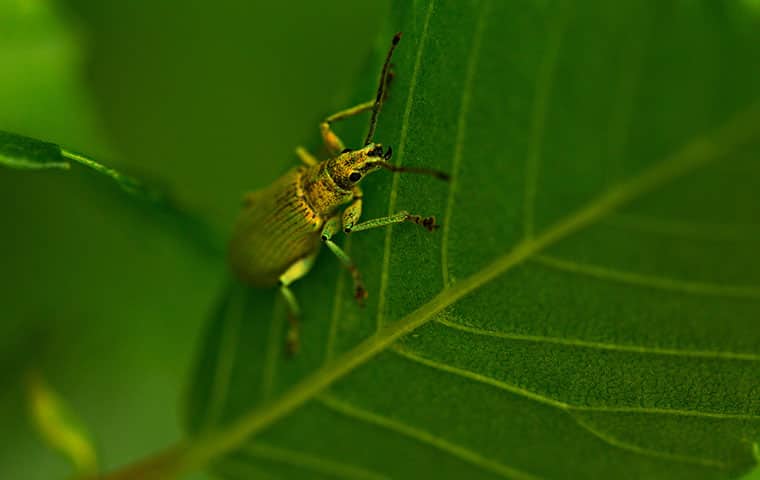
Elm Beetles in Colorado: Understanding and Managing Infestations
Providing Effective Beetle Control Throughout Aspen
Elm beetles are indigenous to Colorado. You’ve almost certainly seen one before, and if you’ve seen a single one, you’ve probably seen hundreds. Every adult elm beetle measures 6 to 8 millimeters in length and displays a range of yellow to green shades. Elm beetles have a dark spot between their two eyes, sometimes mistaken for a third eye. These beetles are herbivores and feed exclusively on leaves and shrubbery throughout their lives. In the western hemisphere, few natural predators target elm beetles, allowing populations to grow rapidly and cause property issues.
Elm beetles flourish in the unique microclimates found in Aspen and Western Colorado, especially during mild springs and early summers. Aspen’s high-altitude environments can extend beetle activity deeper into the growing season, giving these insects more time to feed on local trees. Community efforts to maintain urban forests and monitor beetle activity are essential to managing infestations across Aspen neighborhoods.
Worried about elm beetles damaging your Aspen property? Call RAM Pest Control today for expert Elm Beetle control in Colorado and protect your trees before infestations get out of hand!
Are Elm Beetles a Threat to Your Property?
Elm beetles do not pose a direct threat to people or pets. The most significant risks concern the health of the trees on your property. Elm trees can become skeletonized by feeding beetles, leading to weak branches or even toppled trees in high winds. In winter, elm beetles may seek warmth inside homes. Large infestations can produce excessive beetle waste or dead insects, which sometimes create a cleaning or minor health concern for families and pets. For detailed home prevention strategies, visit our Home Pest Control page.
Many property owners in Aspen witness how quickly a minor beetle presence can damage mature trees. Extensive defoliation caused by beetles often stresses trees, making them more susceptible to disease and storm damage. Protecting tree health supports both property values and the natural beauty that draws residents and visitors to Aspen and the surrounding area.
Why do I have an elm beetle problem?
The number one cause for people in Colorado suffering from elm beetle infestations is elm trees. They are beautiful and you probably enjoy having them on your property, but they are the reason you’re suffering from an infestation. The name “elm beetle” comes from their habit of clustering around these trees.
Warm, dry summer conditions can drive beetle populations higher, making outbreaks more common near Aspen. Mature trees provide both shelter and abundant food, allowing beetles to thrive near homes and businesses. The Roaring Fork Valley’s lack of widespread natural predators means these insects often increase their numbers from year to year.
Where will I find elm beetles?
You may see elm beetles flying around your property. Pets may carry beetles riding on their fur, but these beetles typically cluster on trees and bushes. During cold months, beetles may move indoors in search of warmth. Watch plants inside your home, as beetles will settle on indoor foliage for food and protection.
In Aspen neighborhoods, beetles commonly hide in cracks near windows and beneath siding while sheltering from cold mountain evenings. Many homeowners notice beetles appearing in attics and garages late in the fall, as they slip in through even the most minor gaps in search of winter shelter.
Life Cycle & Seasonal Trends of Elm Beetles
Elm beetles in Aspen follow a predictable life cycle, beginning when adult beetles emerge in spring as temperatures rise. These beetles lay eggs on the undersides of leaves, and larvae hatch in late spring to early summer. As larvae feed on foliage, they cause visible leaf damage and can impact trees throughout the area. By mid-summer, larvae pupate and transform into adults. The climate in Aspen’s high elevations may slow the life cycle when cold snaps occur, but the growing season still allows for ongoing beetle activity until the first frost. Residents often notice beetles migrating indoors as fall approaches, searching for warm places to survive the winter. Recognizing these seasonal patterns helps you prepare for beetle control and plan early action.

Hear From Our Happy Customers
At RAM Pest Control, your satisfaction is our priority! See for yourself what our customers have to say about working with us.
-
“- Richard G
This company is amazing. First, they actually answered their phone. I was able to get scheduled in 5 minutes. Nate was our technician. Very professional and knowledgeable of our snake issue. I cannot say enough good things about this company.
” -
“Thank you Tate...I look forward to seeing you soon.”- Candy A.
-
“- Techno N
Jake did a fabulous job. Very thorough and efficient. Great Job. Thanks!
” -
“- Tyler S
Great team..very responsive and easy to work with. Explains each step of the way and what they are doing to fix the problem.
” -
“- Daniela K
Great pest control company, Tate is very knowledgeable and professional!
” -
“- Joyce G
My tech Tate does a good job, he is knowledgeable, professional, funny and kind...always thinking about my dog's safety when spraying and very good at his follow up to check on my home! Big Thank you to Ram Pest Control and Tate!
” -
“Very nice guy and great service.”- Stephanie F.
-
“- Karna P
Very responsive and professional! I will always use these guys!!
”

Why Choose RAM Pest Control?
-
Over 20 Years of Experience
-
Customer Care Focused
-
Locally Owned & Operated
-
Effective & Affordable
RAM Pest Control's Blog
Want all the latest news or updates? Browse through our blog to read our most recent posts and featured articles.




